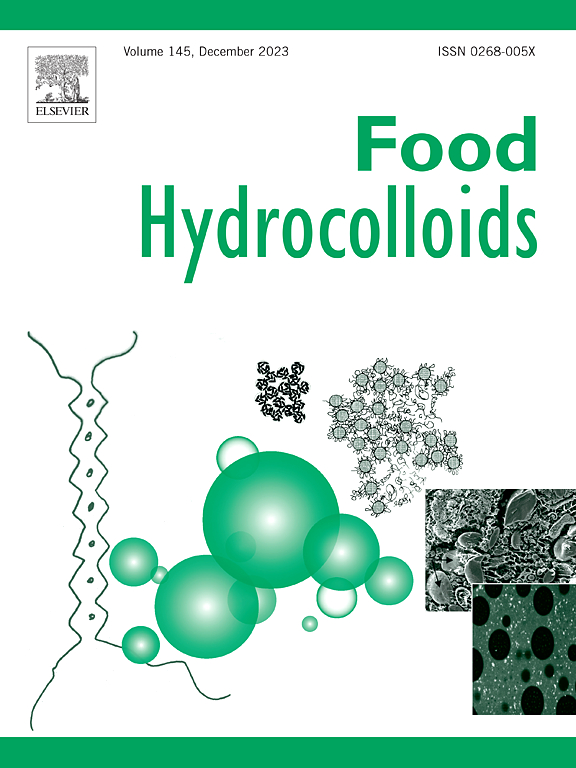Effect of myosin-kappa carrageenan pickering emulsions on the quality of bighead carp surimi gels
IF 11
1区 农林科学
Q1 CHEMISTRY, APPLIED
引用次数: 0
Abstract
Emulsions could be utilized to improve surimi gels. How myosin-kappa carrageenan (κC) Pickering emulsions to affect the quality of bighead carp surimi is still unclear. The particle distribution of myosin-κC Pickering emulsion was characterized as uniform and stable through particle size potential and microstructure observations. The impact of oil substitution rate on the gel quality of bighead carp (Aristichthys nobilis) surimi was investigated by incorporating substitution oil into the surimi. The results indicated that the gel strength and hardness of bighead carp surimi increased significantly with higher oil substitution rates. When the myosin-κC Pickering emulsion completely replaced the oil, the gel hardness of surimi reached its highest level, and the L∗ value and whiteness significantly increased (P < 0.05). Additionally, the water-holding capacity (WHC) of the surimi gel improved with increasing oil substitution rates. Myosin-κC Pickering emulsions were evenly distributed within the gel matrix as small oil droplets, filling the pores of the surimi and effectively enhancing the gel network structure. Sensory evaluation and gas phase ion migration spectrometry demonstrated that the myosin-κC Pickering emulsion improved sensory properties and reduced undesirable flavors when it completely replaced the oil. These results suggest that myosin-κC Pickering emulsion is beneficial for enhancing the properties and flavor of surimi gels.

求助全文
约1分钟内获得全文
求助全文
来源期刊

Food Hydrocolloids
工程技术-食品科技
CiteScore
19.90
自引率
14.00%
发文量
871
审稿时长
37 days
期刊介绍:
Food Hydrocolloids publishes original and innovative research focused on the characterization, functional properties, and applications of hydrocolloid materials used in food products. These hydrocolloids, defined as polysaccharides and proteins of commercial importance, are added to control aspects such as texture, stability, rheology, and sensory properties. The research's primary emphasis should be on the hydrocolloids themselves, with thorough descriptions of their source, nature, and physicochemical characteristics. Manuscripts are expected to clearly outline specific aims and objectives, include a fundamental discussion of research findings at the molecular level, and address the significance of the results. Studies on hydrocolloids in complex formulations should concentrate on their overall properties and mechanisms of action, while simple formulation development studies may not be considered for publication.
The main areas of interest are:
-Chemical and physicochemical characterisation
Thermal properties including glass transitions and conformational changes-
Rheological properties including viscosity, viscoelastic properties and gelation behaviour-
The influence on organoleptic properties-
Interfacial properties including stabilisation of dispersions, emulsions and foams-
Film forming properties with application to edible films and active packaging-
Encapsulation and controlled release of active compounds-
The influence on health including their role as dietary fibre-
Manipulation of hydrocolloid structure and functionality through chemical, biochemical and physical processes-
New hydrocolloids and hydrocolloid sources of commercial potential.
The Journal also publishes Review articles that provide an overview of the latest developments in topics of specific interest to researchers in this field of activity.
 求助内容:
求助内容: 应助结果提醒方式:
应助结果提醒方式:


